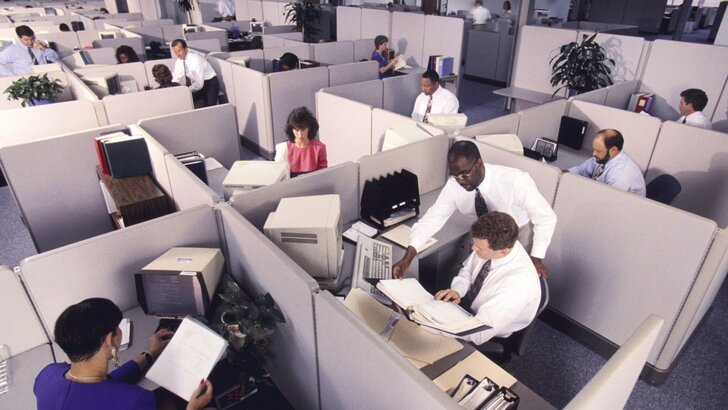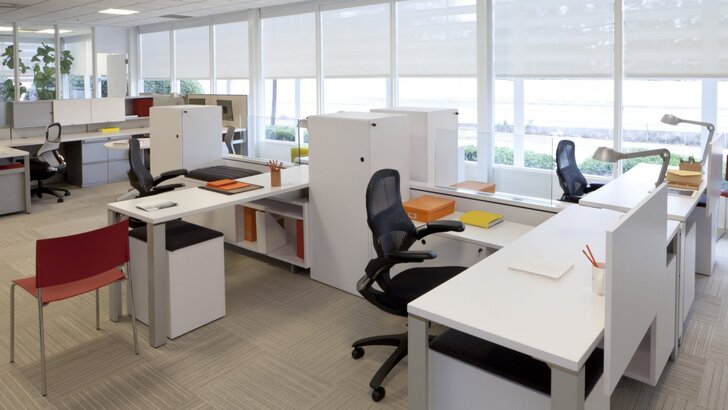
Want to Keep Your Employees Happy? Why Not Introduce an Open Office Setting!

Have you ever found yourself struggling with the confined space of your cubicle? Don’t you feel that in addition to limiting your movements, it also limits your creativity and productivity? If the answer to both those questions is ‘Yes,’ you should know that you’re quite on-point with the whole concept that we’re about to highlight.

Inc | A study has shown that people working in open offices are happier and more productive than those working in confined cubicles
According to a study published in Occupational and Environmental Medicine, workspaces that don’t have partitions propped up between desks, motivate employees to be more involved and help boost productivity. This is in addition to beating workplace stress. Let’s try to delve a little deeper.
Read – Tips to Keep Employees Motivated & Engaged
Open office = open mind
Casey Lindberg, lead researcher of the study, said that his team monitored the relationship between an open office setting and stress and physical activity levels of over 200 government employees. The results of the study were pretty surprising.
It was found that people working in places that had little or no partitions between desks were almost 20 percent more active as compared to people working in confined cubicles. Additionally, they were found to have as much as 14 percent less stress levels than their counterparts in closed cubicles. Makes you really want to switch your outlook towards to workspaces, doesn’t it?

Inc | The study says an open office promotes a healthier body and healthy mind
But the question that really needed to be addressed here was – why is it so? How does the cubicle setting in offices impact employee productivity and stress levels?
Lindberg answered that by pointing out that when people became more aware of the presence of others around them, they were prompted to move to a different place when talking on the phone or having a conversation with someone in person. This led to a change in scene for them while also bringing in physical movement, both of which positively impacted the state of their mind.
He further supported his claim by mentioning that participants were made to wear heart and activity monitoring devices while also being prompted to fill mood-tracking surveys every hour. Keeping influential factors in mind, it was deduced that males were significantly more active than females in office, and also that lean and young workers were less stressed than their older and slightly heavier colleagues.
Read – The Truth About Open Offices
So what does that mean for the future of workspaces?
All things said and done, Lindberg concluded that while an open office layout did seem to promote better mental and physical health, a cause and effect relationship couldn’t directly be proved. There were a lot of factors that also played a part in influencing how people felt in their workspaces. They included the type of work, kind of culture, differences in personalities of the people working in the office, and more.

The Muse | But researchers do say that a clear cause and effect relationship cannot be established between an open office setting and happier employees
But in our opinion (which we’d like to think in unbiased) an open layout office does sound like something where people would generally be happier. Because, after all, workplaces are where people spend most of their time. The environment is bound to affect the mental state at some point, right?
More in business management
-
`
Amazon’s $4 Billion Investment in Anthropic
In a move highlighting the intensifying battle in the tech industry, Amazon recently announced its substantial investment of up to $4...
November 24, 2023 -
`
Is the Future of Shopping Cashless?
The way we shop has significantly transformed in recent years, thanks to the rise of cashless payments. Traditional methods of exchanging...
November 18, 2023 -
`
Jeff Bezos and Lauren Sánchez’s $500 Million Superyacht
Set your course for a journey into the world of maritime magnificence as we unveil the $500 million superyacht belonging to...
November 11, 2023 -
`
Unlocking True Sustainability in Business and Finance
In the race towards a greener future, businesses and financial institutions have been progressing at a snail’s pace despite their public...
November 5, 2023 -
`
The Business of FaZe Clan
In the ever-evolving landscape of professional gaming and esports, few names have left as indelible a mark as FaZe Clan. Established...
October 26, 2023 -
`
7 Benefits of Shopping Sustainably
In a world that’s becoming increasingly aware of the environmental crisis, sustainable shopping has emerged as a powerful tool for individuals...
October 17, 2023 -
`
How the U.K. Became the Supercar Capital of the World
Picture the narrow streets of Milan with the roar of a Lamborghini passing by or the Autobahn with a Porsche zipping...
October 13, 2023 -
`
Fidelity’s Guide to Retirement: How to Join the Millionaire Club
Picture this: You are lounging on a yacht, the sun’s warm rays are making the turquoise waters shimmer. And the best...
October 6, 2023 -
`
Unlocking Opportunities in the Age of Automation
The world is on the brink of a robotic revolution, and it’s not just about the machines taking over. Companies pioneering...
September 28, 2023















You must be logged in to post a comment Login